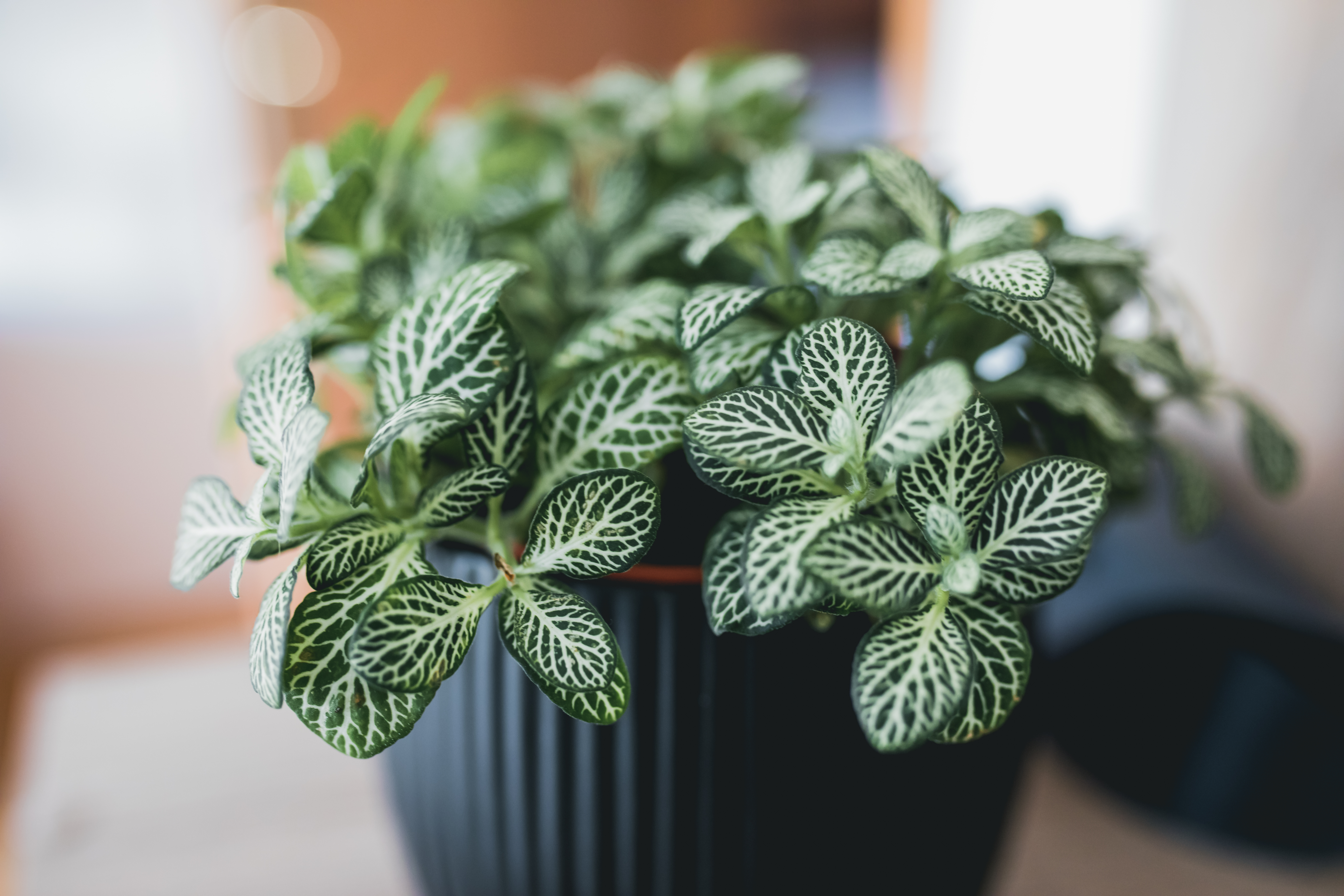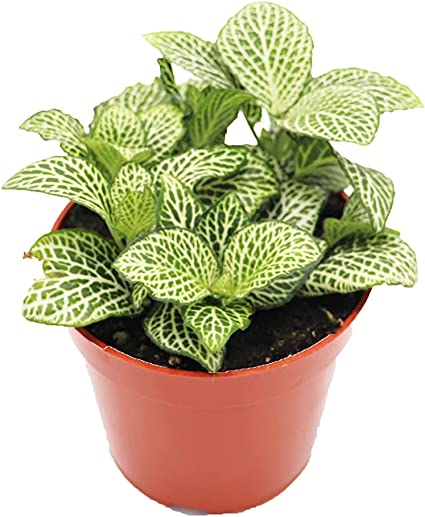
Fittonia is a small staying and colorful houseplant. The main reason people keep this houseplant is the pattern on the leaves. The most common Fittonia has a pattern of silver veins on a light green leaf. There are also varieties with pink, rose, white or green veins. You can read more about these different species further down this page. This pattern on the leaves is why Fittonia is nicknamed the Mosaic plant. Depending on the species, the leaves never grow larger than a few centimeters. The plant originates from Peru where it grows as a ground cover. A Fittonia can spread out over an area of about 30 centimeters. They can grow up to 15 centimeters high, although they often stay below this. In its natural habitat, a Fittonia can bloom, but as an indoor plant, this rarely happens. Looking for a larger colorful houseplant? Then take a look at the Calathea.
It is a fun houseplant, but at the same time very temperamental. The plant has quite a few requirements in terms of care. You can read about these requirements further on, as well as the different types of Fittonia and common problems.
Table of Contents
Fittonia care

The highest priority in the care of the Fittonia: a high humidity. This is one of the most important conditions for these plants to grow beautifully. These houseplants should always be in a humid environment, because they dry out quickly. Watering is also important, but not enough. If you have a Fittonia you will probably recognize this problem. It is really important to let the plant grow in an environment with high humidity. You can solve this problem in a number of ways:
- Use these plants as ground cover in a terrarium. You also often see a Fittonia in a sealed bottle or pot. This simulates a tropical environment and the humidity is very high.
- A second option is to choose a location in the bathroom. There it is often warm and very humid. The ideal conditions.
- Finally, you can also choose to mist the leaves daily with a plant sprayer. In this way you can still meet the requirements in terms of humidity.
Watering
When you have your Fittonia in a terrarium or closed pot you don’t have to worry about this part. In this closed system it is always moist enough and your plant will, if all goes well, have a great time.
For those who have these plants in a living room or bedroom watering is an essential part of the care. The right way of watering is important because Fittonias are very picky when it comes to the amount and frequency of watering.
First, the soil should never be too soggy. If these plants are left in soggy soil for a long time, the roots will rot. This will result in loss of leaves and eventually the plant will die. Never water your plants when the soil is still wet! You can easily check this by sticking your finger in the soil. Does soil stick to your finger? Then the soil is still wet and you should not water.
Also, the soil should never dry out completely. The leaves will then become dry and can easily break. If this happens briefly the plant can still spring back when you water it, but after a longer period of drought no more recovery takes place. Below in the video you can see in time lapse the recovery of a dried up Fittonia.
Pot and choice of soil
As indicated above, soil that is too wet and boggy will cause major problems for the Fittonia. You can largely prevent this problem by adapting the pot.
You should always make a hole in the bottom of the pot. This allows excess water to drain away. An additional advantage is that residues of plant food are flushed out of the soil by watering. You can further improve this drainage by placing a layer of hydro grains at the bottom of the pot. If necessary, you can place a saucer under the pot so that water does not end up on furniture.A standard potting soil for houseplants will suffice because it retains moisture reasonably well. This is a property that the Fittonia appreciates.
The right amount of light
Your Fittonia requires a lot of light. But beware: never direct sunlight. If direct sunlight shines on the leaves, they may burn or shrivel. This may sound a bit dramatic, but the plant is simply not used to this. In its natural habitat this plant grows as a ground cover under other plants so it never gets direct sunlight.
At the same time, the plant does need a lot of light to grow well and maintain its beautiful color. Especially if you have a Fittonia with bright colors, such as red or pink, the amount of light is important. If the plant is too dark, these colors can fade. In the worst case, the leaves can even become completely plain.
So the best is a spot close to a window on the north or east. In that location there is a lot of light, but actually never direct sun. If the sun does shine it is in the early morning. Then the sun is not hot enough to do any real damage. You may notice that after a while your Fittonia is no longer symmetrical. This is because the plant is growing towards the light. Do you want to keep it symmetrical? Then turn the pot a quarter turn weekly
Nutrition
A potted Fittonia depends on the nutrients available in the soil. It is a small plant, but can grow considerably. The available nutrients will be used up quickly.
Especially in spring and summer you can almost see this plant grow. Many new stems and leaves are produced. To facilitate this growth it is important that you add plant food every two weeks in the spring and summer. In addition to healthy growth, nutrition also helps maintain the color of the leaves.always read the instructions on the packaging of the plant food carefully. It happens quickly that you give too much and this can be harmful for the plant.
Pruning
Pruning is important to keep the plant in good shape. If you do not prune, there is a chance that the stems will grow in all directions. It may also happen that the distance between the leaves becomes longer and longer. In short: the plant is no longer beautiful.
The maintenance pruning is fairly simple. Simply top off the tips of the stems by one centimeter. This stimulates the plant to grow back fuller. If you do this regularly, the plant will keep its shape.
Temperature
Fittonia originally grows in the tropical rain forests of Peru. You would not know it, but this plant can tolerate temperatures up to 10 degrees Celsius. However, this does not mean that the plant will grow well below these temperatures. If you want to ensure good growth and beautiful colors, keep the temperature always above 18 degrees.Note also sudden fluctuations in temperature. These can be caused by an open window or a radiator that is turned on. This can not appreciate a Fittonia.
Fittonia species
Fittonia is a plant genus which falls within the Acanthaceae family. By far the most Fittonia species we encounter in garden centers are cultivars of the Fittonia Albivenis (or: Fittonia Verschaffeltii). Some well-known varieties include the Forest Flame and the Skeleton (pictured below).
Besides these variations there are almost countless color combinations imaginable. The Fittonia never gets bored! With all these variations we would almost forget that another special species grows in nature: Fittonia Gigantea. With leaves that can be up to 10 centimeters long, the Gigantea lives up to its name. These leaves are dark green and have dark red veins in the same patterns as the Verschaffeltii
The flower of the Fittonia
In the natural (tropical) environment, of course, this plant grows best. There the days are long, it is warm and the Fittonia enjoys very high humidity. In this natural environment, it happens regularly that these little plants bloom. Just as native plants bloom in our country
You can do your best, the care as an indoor plant is never as optimal as the natural conditions. Sometimes it is possible to make the plant bloom. This mainly happens in terrariums, but sometimes simply in the living room.
The way of flowering is special. Towers grow above the plant from which the flowers grow. These are reminiscent of the flowering of the Banana plant (Musa). Below on the photo you can see this well. Would you rather keep the plant for the leaves? Cut away the flower buds as soon as they appear. This will return the energy to the leaves.

Frequently asked questions
Can you take cuttings from Fittonia?
Yes you can! This plant is easy to propagate. Read about it on our page about Fittonia cuttings.
Why do the leaves have no pattern?
Don’t worry: new leaves are usually completely plain at first. Only when they are fully grown do the beautiful colors and patterns appear. If this still does not happen after full growth there may be something else going on. It is good to pay attention to aspects such as nutrition and amount of light. At the top of this page you can read tips about this.
How often should you repot Fittonia?
Since this plant grows fast, you should repot it every year. After the plant has reached a height of 15 centimeters this is no longer necessary. Then the plant is fully grown. Repotting is best done in the spring. Then the plant enters the growth phase and is full of energy. It will then recover quickly from the move.
Is Fittonia poisonous?
Fortunately the Fittonia is not poisonous to humans or (domestic) animals. So you can safely put this nice houseplant on the table if, for example, there are cats roaming around the house.
Yellow leaves
If you give the plant too much water for a long time, the soil will become boggy. This causes wilting and yellow leaves. Read the care tips at the top of this page for the right way and frequency of watering.
The leaves curl up
If the leaves curl up, they have usually become hard. They then break off easily. This is a signal that the Fittonia is not enjoying itself. Curled up leaves are usually caused by too much direct sunlight and low humidity. Move your plant to a spot out of the sun and spray the leaves daily with a plant sprayer. This should make the plant feel much better! You can see this in many popular houseplants, such as the Strelitzia or the Philodendron.
Brown leaf edges
Sometimes your beloved Fittonia develops brown leaves, or brown edges to the leaves. This is usually a sign of too much light. Remember, this little plant almost never gets sunlight in its natural habitat, so it is comfortable with a position that is a little shadier
It may happen that you put your plant somewhere and then the days get longer. Because the sun is in a different position it now shines on the plant, where it did not before. Pay attention to this and if necessary move the plant to a place where the sun’s rays do not reach the leaves.
The Fittonia hangs limply
This is normally a sign of dehydration. Give the plant a watering and wait for an hour. If all goes well it will spring right back up!
Summary
| Botanical name | Fittonia Albivenis or Fittonia Verschaffeltii |
| Also known as | Mosaic plant, Nerve plant |
| Water | Keep slightly moist |
| Maximum height | 15 inches |
